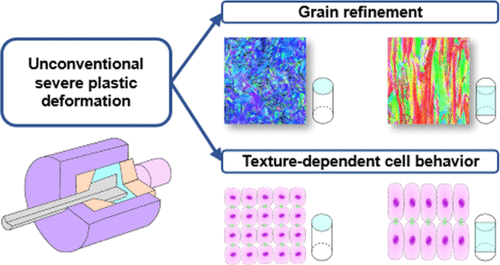当前位置:
X-MOL 学术
›
ACS Biomater. Sci. Eng.
›
论文详情
Our official English website, www.x-mol.net, welcomes your feedback! (Note: you will need to create a separate account there.)
Texture-Governed Cell Response to Severely Deformed Titanium
ACS Biomaterials Science & Engineering ( IF 5.8 ) Pub Date : 2020-12-21 , DOI: 10.1021/acsbiomaterials.0c01034 Daniel Wojtas 1, 2 , Aldona Mzyk 2, 3 , Jakub Kawałko 4 , Gabriela Imbir 2 , Klaudia Trembecka-Wójciga 2 , Mateusz Marzec 4 , Anna Jarzębska 2 , Łukasz Maj 2 , Krzysztof Wierzbanowski 1 , Robert Chulist 2 , Wacek Pachla 5 , Krzysztof Sztwiertnia 2
ACS Biomaterials Science & Engineering ( IF 5.8 ) Pub Date : 2020-12-21 , DOI: 10.1021/acsbiomaterials.0c01034 Daniel Wojtas 1, 2 , Aldona Mzyk 2, 3 , Jakub Kawałko 4 , Gabriela Imbir 2 , Klaudia Trembecka-Wójciga 2 , Mateusz Marzec 4 , Anna Jarzębska 2 , Łukasz Maj 2 , Krzysztof Wierzbanowski 1 , Robert Chulist 2 , Wacek Pachla 5 , Krzysztof Sztwiertnia 2
Affiliation

|
The phenomenon of superior biological behavior observed in titanium processed by an unconventional severe plastic deformation method, that is, hydrostatic extrusion, has been described within the present study. In doing so, specimens varying significantly in the crystallographic orientation of grains, yet exhibiting comparable grain refinement, were meticulously investigated. The aim was to find the clear origin of enhanced biocompatibility of titanium-based materials, having microstructures scaled down to the submicron range. Texture, microstructure, and surface characteristics, that is, wettability, roughness, and chemical composition, were examined as well as protein adsorption tests and cell response studies were carried out. It has been concluded that, irrespective of surface properties and mean grain size, the (101̅0) crystallographic plane favors endothelial cell attachment on the surface of the severely deformed titanium. Interestingly, an enhanced albumin, fibronectin, and serum adsorption as well as clearly directional growth of the cells with preferentially oriented cell nuclei have been observed on the surfaces having (0001) planes exposed predominantly. Overall, the biological response of titanium fabricated by severe plastic deformation techniques is derived from the synergistic effect of surface irregularities, being the effect of refined microstructures, surface chemistry, and crystallographic orientation of grains rather than grain refinement itself.
中文翻译:

纹理控制的细胞对严重变形钛的响应
在本研究中已描述了在通过非常规的严重塑性变形方法(即静液压挤压)处理的钛中观察到的优异生物学行为的现象。在这种情况下,仔细研究了晶粒的晶体学取向变化显着但仍具有可比的晶粒细化的试样。目的是找到微观结构缩小到亚微米范围的钛基材料增强生物相容性的明确原因。检查了质地,微观结构和表面特性,即润湿性,粗糙度和化学组成,以及蛋白质吸附测试和细胞反应研究。得出的结论是,无论表面性质和平均晶粒尺寸如何,(101̅0)晶面有利于严重变形钛表面上的内皮细胞附着。有趣的是,在主要暴露于(0001)面的表面上观察到白蛋白,纤连蛋白和血清吸附增强,并且具有优先定向的细胞核的细胞明显定向生长。总体而言,通过严格的塑性变形技术制造的钛的生物响应源自表面不规则性的协同效应,这是晶粒细化的微观结构,表面化学性质和晶体学取向的影响,而不是晶粒细化本身。在主要暴露(0001)面的表面上观察到了血清吸附以及具有优先取向的细胞核的细胞的明显定向生长。总体而言,通过严格的塑性变形技术制造的钛的生物响应源自表面不规则性的协同效应,这是晶粒细化的微观结构,表面化学性质和晶体学取向的影响,而不是晶粒细化本身。在主要暴露(0001)面的表面上观察到了血清吸附以及具有优先取向的细胞核的细胞的明显定向生长。总体而言,通过严格的塑性变形技术制造的钛的生物响应源自表面不规则性的协同效应,这是晶粒细化的微观结构,表面化学性质和晶体学取向的影响,而不是晶粒细化本身。
更新日期:2021-01-11
中文翻译:

纹理控制的细胞对严重变形钛的响应
在本研究中已描述了在通过非常规的严重塑性变形方法(即静液压挤压)处理的钛中观察到的优异生物学行为的现象。在这种情况下,仔细研究了晶粒的晶体学取向变化显着但仍具有可比的晶粒细化的试样。目的是找到微观结构缩小到亚微米范围的钛基材料增强生物相容性的明确原因。检查了质地,微观结构和表面特性,即润湿性,粗糙度和化学组成,以及蛋白质吸附测试和细胞反应研究。得出的结论是,无论表面性质和平均晶粒尺寸如何,(101̅0)晶面有利于严重变形钛表面上的内皮细胞附着。有趣的是,在主要暴露于(0001)面的表面上观察到白蛋白,纤连蛋白和血清吸附增强,并且具有优先定向的细胞核的细胞明显定向生长。总体而言,通过严格的塑性变形技术制造的钛的生物响应源自表面不规则性的协同效应,这是晶粒细化的微观结构,表面化学性质和晶体学取向的影响,而不是晶粒细化本身。在主要暴露(0001)面的表面上观察到了血清吸附以及具有优先取向的细胞核的细胞的明显定向生长。总体而言,通过严格的塑性变形技术制造的钛的生物响应源自表面不规则性的协同效应,这是晶粒细化的微观结构,表面化学性质和晶体学取向的影响,而不是晶粒细化本身。在主要暴露(0001)面的表面上观察到了血清吸附以及具有优先取向的细胞核的细胞的明显定向生长。总体而言,通过严格的塑性变形技术制造的钛的生物响应源自表面不规则性的协同效应,这是晶粒细化的微观结构,表面化学性质和晶体学取向的影响,而不是晶粒细化本身。


























 京公网安备 11010802027423号
京公网安备 11010802027423号